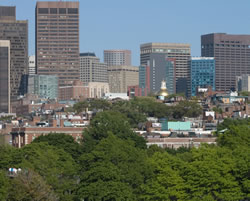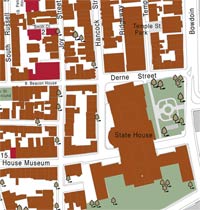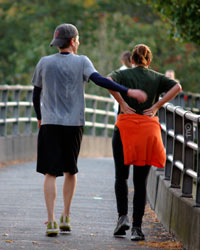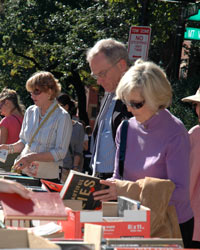Our Neighborhood
|
Neighborhood Overview
Beacon Hill is a 19th-century downtown Boston residential neighborhood situated directly north of the Boston Common and the Boston Public Garden. Most people think of city living as anonymous and isolating. But this neighborhood of about 10,000 people is more like a village than an anonymous city. It has a rich community life in which many people know each other and meet on the Hill's commercial streets and at various activities and meetings. Less than one-half mile square, Beacon Hill is bounded by Beacon Street, Bowdoin Street, Cambridge Street, and Storrow Drive. It is known for its beautiful doors and door surrounds, brass door knockers, window-shutters, brick sidewalks, gas lights, flowering trees, window boxes and hidden gardens. Its architecture, mostly brick row houses built during the 1800’s, includes the Federal, Greek Revival and Victorian periods. As a designated National Historic Landmark District, the architecture is protected by regulations that allow no changes to the exterior of a structure which is visible from a public way without the approval of the City of Boston’s Beacon Hill Architectural Commission. Beacon Hill contains a South Slope, a North Slope and the Flat of the Hill. Charles Street is the neighborhood's “Main Street” with retail shops, restaurants, and neighborhood services. The Massachusetts State House is at the top of the Hill overlooking Boston Common. The Beacon Hill neighborhood is named for a beacon once located at the highest point in central Boston. Today that is the site of the Massachusetts State House. From 1625 to 1635, the area was owned by a single person, William Blaxton (Blackstone), the first European settler. Most of the brick homes were built during the 1800’s. Resource: www.beaconhilltimes.com http://en.wikipedia.org/wiki/Beacon_Hill,_Boston |
Download the full map:
| ||
|
Residential Life
The compact geography of the area makes it very walkable. Beacon Hill residents have easy access to public transportation (MBTA) and commuter trains (North Station/South Station). Parking is limited on the residential streets and requires a resident parking permit issued by the City of Boston. A number of public parking garages are located in the area. It is important to follow all street signage carefully and to respect street cleaning, snow removal and emergency vehicle requirements. The residential density of the neighborhood necessitates careful attention to trash disposal regulations and the curbside recycling program offered by the City of Boston. Beacon Hill is architecturally distinct, historically venerable, and socially vibrant for all ages, from families with children to elders enjoying a downtown life. With parks and playgrounds surrounding the streets, dogs are welcome, as long as city rules for their ownership and care are followed. While Beacon Hill has a well-earned reputation for safety, residents and visitors are still advised to remain alert to their surroundings, particularly after dark, and to report serious incidents to the Boston Police. Living on Beacon Hill is perhaps the most European-like residential experience in the United States. Most residents appreciate the nearby city parks, cultural venues, access to world-class education and medical care, restaurants of all types, and other services. The sense of “community” is welcoming to all. |
|
People
Approximately 10,000 people live on Beacon Hill, each contributing to the neighborhood’s vibrant and diverse demographic mix of the neighborhood. Many families with children live in the neighborhood. Some residents, with grown children, have lived on the Hill since they were children themselves. Others are more short term; from doctors and hospital workers at Massachusetts General Hospital to young professionals starting their careers and students studying at local schools. The unique mix of residents is part of the area’s special charm and the neighborhood truly offers something for everyone. |




